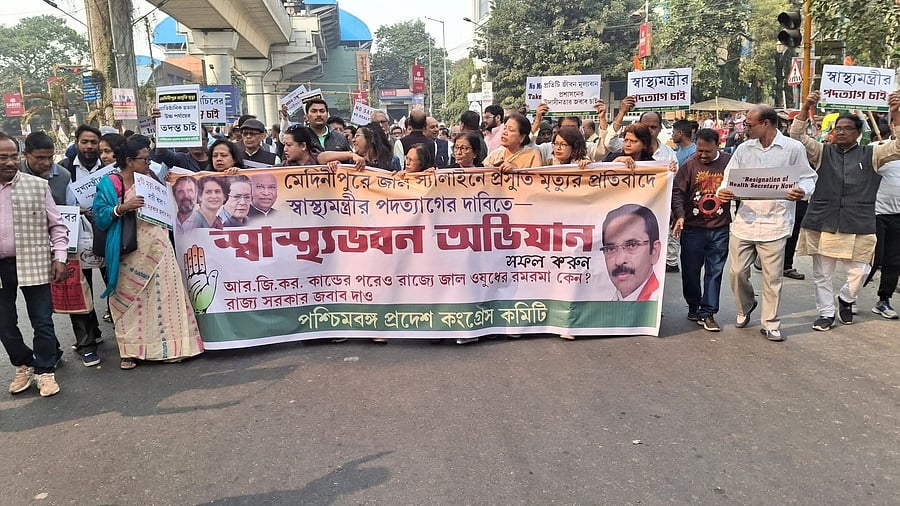
Led by state Congress president Subhankar Sarkar, party workers staged a protest rally from Karunamoyee More to Swasthya Bhavan in Sector V in Kolkata.
Credit: X/@subhankar_cong
Kolkata: Amidst an existential crisis and a declining presence in Bengal, the Congress remains divided over its strategy for the 2026 Assembly elections with three factions emerging: one advocating an alliance with the TMC, another favouring continued adjustment with the Left Front, and a third pushing for a solo contest to revive the party’s fortunes.
The Congress in Bengal has been grappling with a weakened organisational structure due to the exodus of its leaders to the TMC and BJP, as well as persistent infighting.
Its last significant electoral success came in 2011, when, in alliance with the TMC, it helped end the Left Front’s 34-year rule.
Congress's vote share, which stood at 14 per cent in 2011, plummeted to 3 per cent in the 2021 state polls, and it currently has no seats in the Assembly.
One faction within Congress believes that historical alliances have only weakened the party.
This group blamed the TMC-Congress alliance in the 2009 Lok Sabha and 2011 Assembly elections, arguing that it weakened the grand old party as many of its leaders defected to Mamata Banerjee’s camp.
Similarly, it criticised the Congress-Left alliance formed in 2016 for prioritising seat-sharing over rebuilding the Congress’s grassroots support.
Pradip Bhattacharya, former state Congress president, commented on the current divide, saying, "It is true that we are facing a political existential crisis in Bengal. The state unit is now divided on three opinions — whether to continue with the Left, align with the TMC, or contest alone. However, I believe we would benefit from continuing with the Left for a respective alliance." In contrast, another faction argued that Congress, given its current weak presence in the state, cannot afford to contest the 2026 Assembly elections alone. They view Mamata Banerjee's TMC as the only viable option for a seat-sharing arrangement.
State Congress president Shuvankar Sarkar is pushing for strengthening the party's base before any decision is made on alliances.
He stressed, "The Congress has suffered for years because alliances have helped the other partners, not us. My task is to increase the party's presence and visibility across the state. Only then can we discuss alliances or going solo in the polls." He questioned the rationale behind aligning with the TMC, which, he argued, has "ruined" the party in Bengal, or with the Left, which he claimed has not been supportive beyond seat-sharing arrangements.
While all three parties — Congress, the Left and TMC — are part of the national opposition INDIA bloc, the Congress-Left alliance in West Bengal opposes both the TMC and the BJP.
Congress's presence has steadily declined between 2011-2021, when nearly 70 MLAs and one MP defected to the TMC.
In the 2024 Lok Sabha elections, the party's vote share further dwindled from 5.6 per cent in 2019 to 4.6 per cent, and the party secured just one seat.
Adhir Ranjan Chowdhury, a prominent Congress leader and former state president, has been a strong advocate for maintaining the Left-Congress alliance.
He pointed out that the Congress-Left coalition did well in the 2024 Lok Sabha elections, with Congress leading in 12 Assembly segments, even surpassing both TMC and BJP in terms of votes in those areas.
"In the last Lok Sabha polls, we were ahead in 12 assembly seats. The combined effort of the Left and Congress has helped us achieve that. We should not ignore these positive aspects when evaluating our path forward," Chowdhury said.
The top three Congress leaders in Bengal, despite having differing views on how to revive the party, which ruled the state until 1977 except for a brief period of the United Front government, agree on the need to challenge the communal divide created by the TMC and BJP.
"It is necessary to counter the Hindu-Muslim binary that helps both the TMC and BJP electorally. Both parties are complementing and supplementing each other through their politics and policies, and we must break this combination," said Sarkar.
In the 2024 Lok Sabha elections, a triangular contest between the TMC, the Congress-Left alliance, and the BJP resulted in the TMC winning 29 seats, the BJP securing 12, and Congress managing just one seat, with the grand old party rejecting the TMC's offer of two seats in favour of maintaining its alliance with the CPI(M)-led Left Front.
A senior TMC leader noted, "The party in Bengal has nothing to win or lose by allying with the Congress; rather, it is the Congress that stands to gain. Now, the Congress has to decide whether they want to remain politically irrelevant by allying with the CPI(M) or stay relevant in state politics." The CPI(M) has also shown reservations about the future of its alliance with Congress as both the parties fought the last Bengal bypolls in six seats alone.
Political analyst Suman Bhattacharya suggested that Congress's internal discord on alliances stems from its struggle to balance its vote base, particularly in minority-dominated districts like Malda and Murshidabad.
"The mismatch between the anti-Mamata Banerjee state leadership and the anti-BJP vote bank of the Congress primarily in the minority-dominated districts is taking a toll on it. By opposing TMC, they risk losing crucial minority votes. At the same time, they need to assess whether their alliance with the Left has been electorally beneficial," he said. PTI PNT MNB